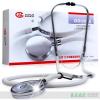- 相关产品推荐
-
89.00
可以在计算机上显示心音的新型听诊器
一种新型“可视听诊器”可以在计算机屏幕上显示三维心音图像,2004年10月在美国拉斯维加斯(Las Vegas, NV,USA)举行的美国麻醉医师年会上展示了这种设备。
日本Mamamatsu大学医学院的Hiroshi Makino博士与同事一起发明了这种新型听诊器。他说:由单个医生来客观评介患者病情是十分困难的,对这些病情的描述往往过于主观。当听取患者心音时,医生必须清楚了解最细微的变化,但是传统的听诊器并不能很好地为医生提供所必需的信息。
这种新型听诊器被称为VisiStetho,在计算机屏幕上通过三维的上升与下降波浪来显示可见的心音曲线。当医生知道什么是正常心音图形的时候,就可以将患者心音与正常心音相比较,并在计算机屏幕上或者打印件上很容易地看出异常。也可以通过总结几个医生对该听诊器提供资料的多数意见而做出临床诊断。目前VisiStetho需要将患者同时连接在话筒、二氧化碳描记装置、心电图上,然后将这些结果被输送到控制台,通过计算机软件来来处理输出结果。打印件可以贴在患者医疗记录中。
但是Makino博士解释说:“VisiStetho仍然处于发展之中。当我们能够将它的体积减小,比如说减少到手机大小,并且加速诊断过程,VisiStetho就会被全球医生广泛使用。”
Novel Stethoscope Shows Heart Sounds on Computer
A new “visual stethoscope” reproduces heart sounds as three-dimensional (3D) images on a computer screen. The instrument was introduced at the annual meeting of the American Society of Anesthesiologists in Las Vegas (NV, USA) in October 2004.
Objective evaluation of a patient’s condition is difficult when conducted by a single individual, and the results tend to be described too subjectively. Doctors need to be aware of the most subtle variations when dealing with heart sounds in a patient, but conventional stethoscopes do not always give them the information they need, according to Dr. Hiroshi Makino, an anesthesiologist at the Mamamatsu University School of Medicine (Japan), who developed the new stethoscope along with colleagues.
Called VisiStetho, the scope works by visualizing heart sounds as 3D rising and falling waves on a computer screen. When doctors know what healthy waves look like, they can compare their patients’ heart sounds to the healthy waves and easily see aberrations by simply looking at a computer screen or printout. The stethoscope also makes it easy to reach a diagnosis through a consensus of several doctors. Currently, the VisiStetho requires that a patient be hooked up simultaneously to a microphone, capnogram, and electrocardiogram, which are fed into a console box and interpreted by computer software. The printout can be attached to the patient’s medical record.
“The VisiStetho is a developing tool,” explained Dr. Makino. “But when we can downsize it to, say, the size of a cellular telephone and speed up the diagnosis process, the VisiStetho will be used by doctors worldwide.”


